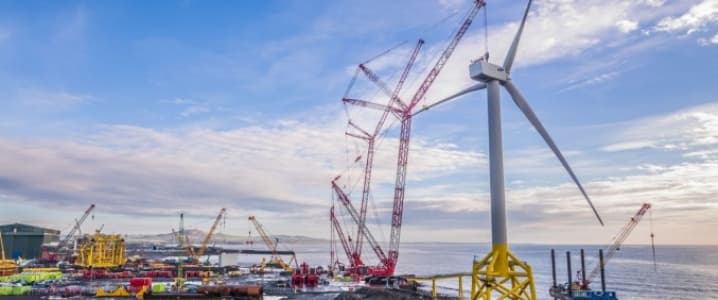U.S. wind farm project developers continue to announce new wind power capacity in an industry that grew eight percent last year and contributes more than US$1 billion in state and local taxes every year.
But the trade war with China and tariffs on Chinese imports threaten to slow down the U.S. wind industry growth.
U.S. wind power construction and development jumped to a record level in the first quarter of 2019, with development pipeline increasing by 6,146 megawatts (MW)—more than the capacity of all operational wind farms in California, the American Wind Energy Association (AWEA) said in a recent report.
However, the same association and companies in the industry warn that the rapid growth of U.S. wind industry jobs and wind power development could slow down or even decline, due to the tariffs on Chinese imports and the still-alive threat of tariffs on Mexican imports.
“We are very concerned about the impact of tariffs on jobs,” the chief executive of AWEA, Tom Kiernan, told CNBC this week.
“We would have been hiring more people if it weren’t for the current tariffs. And if the tariffs increase, as the president is proposing, that will either further reduce our growth or could at some point lead to a decline in the number of jobs in the wind industry,” Kiernan added.
The tariffs on imported Chinese products, on some of which U.S. wind power developers rely for parts in the construction of wind turbines, come at a booming time for the wind power sector in the United States.
According to AWEA’s annual report for 2018, U.S. wind power capacity increased by 8 percent in 2018 to 96,433 MW of total installed wind capacity. This is more than double the capacity that the U.S. had in 2010. The industry supported 114,000 jobs in 2018 across all states, and added last year 8,500 wind power jobs, including well-paying jobs in wind turbine service, construction, engineering, and manufacturing. Related: Escalating Trade War Signals More Pain For Oil
According to the Bureau of Labor Statistics, the job of a wind turbine service technician is expected to be the second-fastest growing occupation in the U.S. by 2026, right after another renewable energy related job, solar photovoltaic installer.
The current prospects for the wind power industry and jobs in the sector are excellent, according to the BLS, but the industry association sees a threat from the tariffs on both employment and development.
The tariff war with China puts 21,000 wind industry jobs across the United States at risk, mostly in rural areas, according to an AWEA fact sheet.
Tariffs on Chinese parts and steel and aluminum products “overwhelmingly impact U.S. manufacturers, creating millions in unforeseen costs that could endanger up to a quarter of future U.S. wind projects. Those lost projects will create a ripple effect of lost jobs throughout the wind industry, from factory workers to farmers to truck drivers nationwide,” AWEA has warned.
The newly announced wind projects in Q1 bring the total U.S. construction and advanced development wind pipeline to a record-breaking 39,161 MW, up by 11 percent compared to the previous quarter, the AWEA says in its Q1 2019 report, noting that eight states are on track to double their installed wind capacity. Related: The $200 Billion Push In Offshore Oil & Gas
More than half of all electricity generated from wind power in 2018 came from just four states—Texas, Oklahoma, Iowa, and Kansas, the EIA said last week.
The largest oil-producing region in the United States, Texas, is also the American champion in wind power installation and electricity generation. Texas has accounted for more than 25 percent of U.S. wind electricity generation in each of the past three years, the EIA said.
However, the wind power industry fears that tariffs and threats of tariffs add a layer of uncertainty to one of the fastest-growing sectors and job markets in the United States.
By Tsvetana Paraskova for Oilprice.com
More Top Reads From Oilprice.com:
- Small Crude Build Sends Oil Lower
- Have Canadian Oil Prices Hit The Sweet Spot?
- This Overlooked Canadian Oil Niche Is Making Traders Billions



















And while hydrogen could play a small role in global transport, it will always be a very minor fuel in the energy mix of today and tomorrow.
The UK Institution of Engineering and Technology is exaggerating when it says that hydrogen could come to replace natural gas as a fuel for heating in the country. Why produce hydrogen from natural gas when one can use natural gas directly.
And while hydrogen fuel cells (FCVs) could eventually take their place in the global transport system, their impact will be limited. Even with the advances made in hydrogen technology over the past 10 years, there are still many challenges to be overcome before hydrogen FCVs can compete in the market with current vehicle technology.
The most significant challenge is the cost and durability of the fuel cell system. Another challenge is that the numbers of FCVs sold and out on roads worldwide is quite small. Only 1,074 fuel cell vehicles were sold in the US during 2016. The numbers for Europe are even much smaller.
Experts estimate it will take 40 years or more before hydrogen has any meaningful impact on gasoline consumption or global warming.
Dr Mamdouh G Salameh
International Oil Economist
Visiting Professor of Energy Economics at ESCP Europe Business School, London